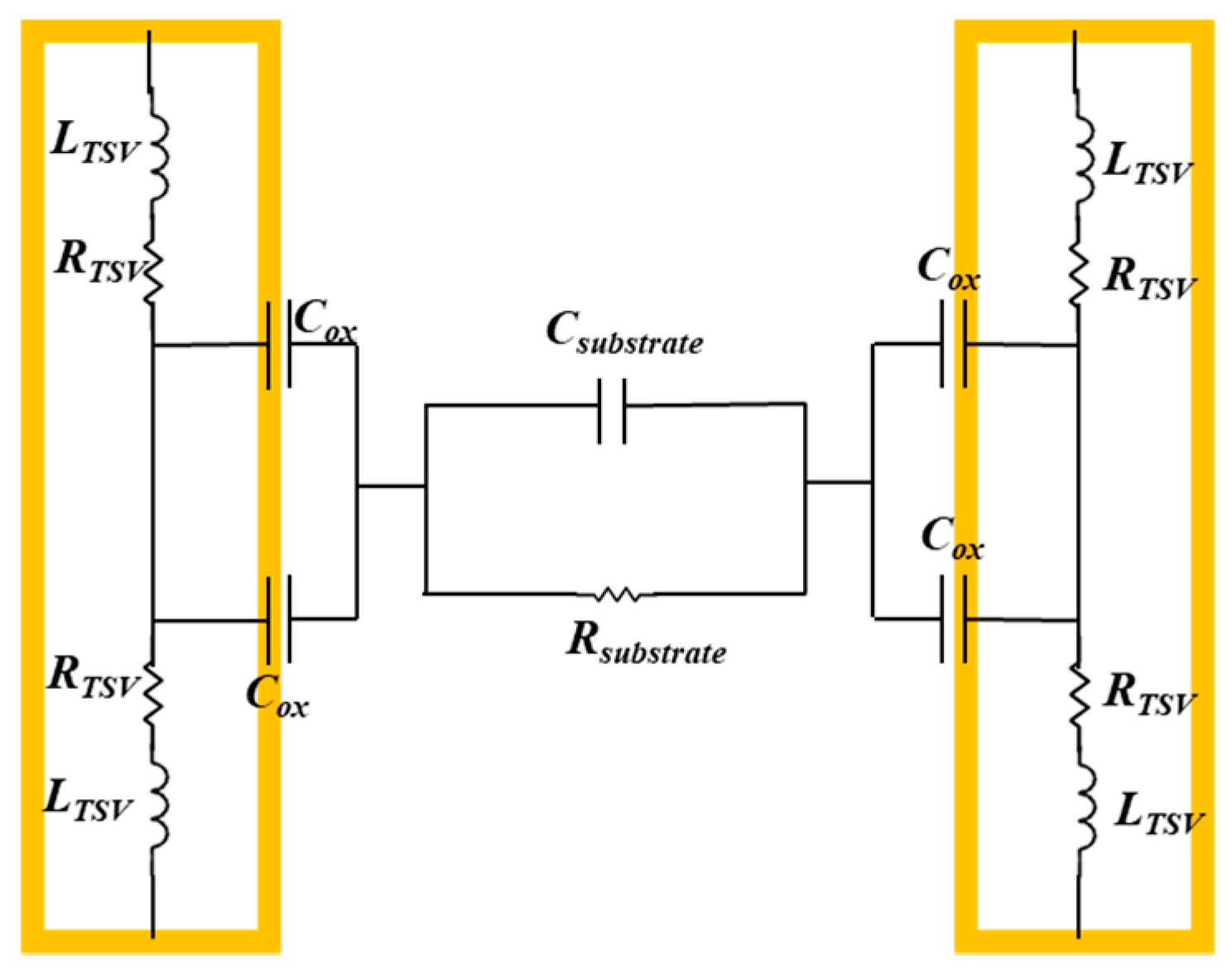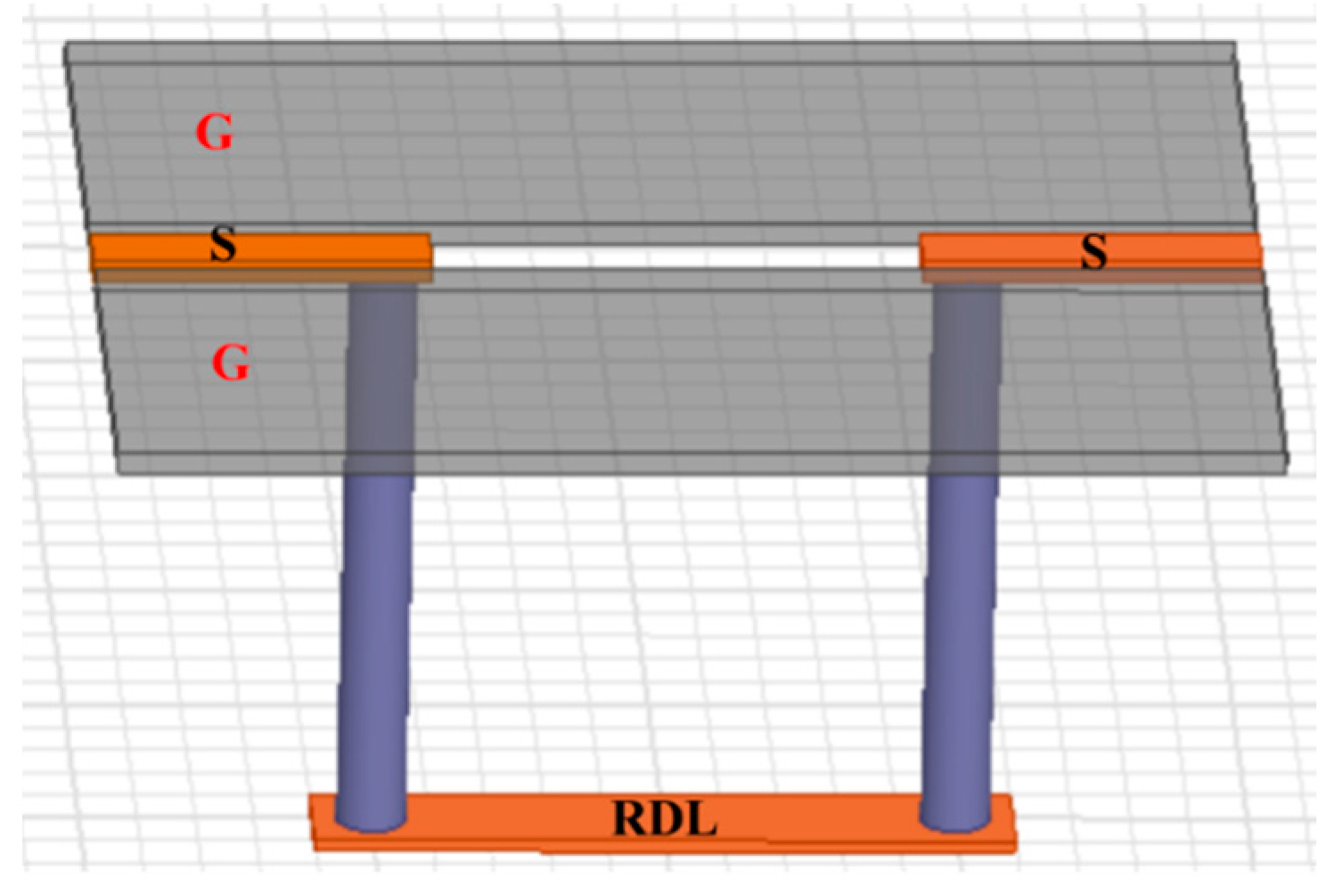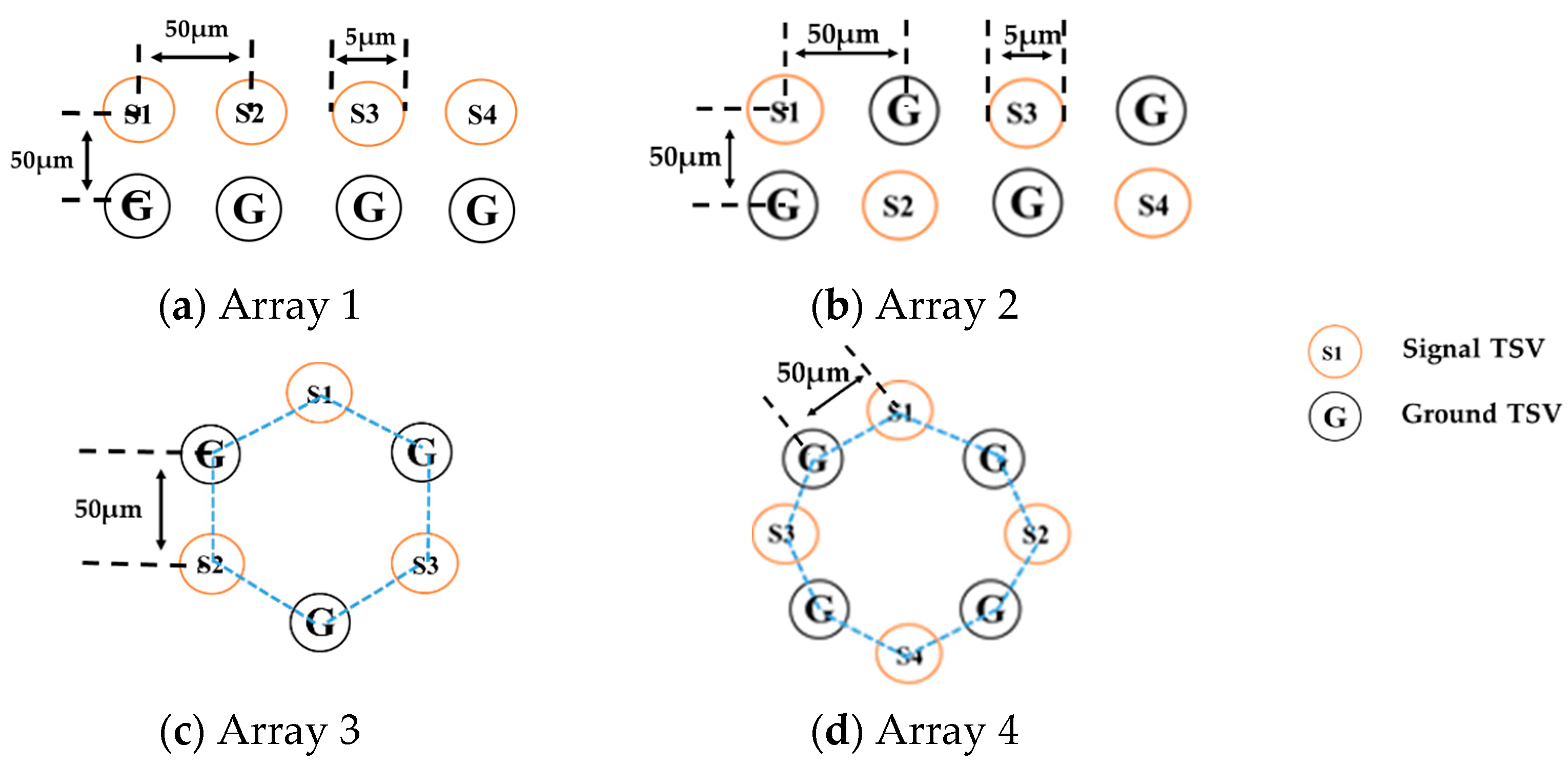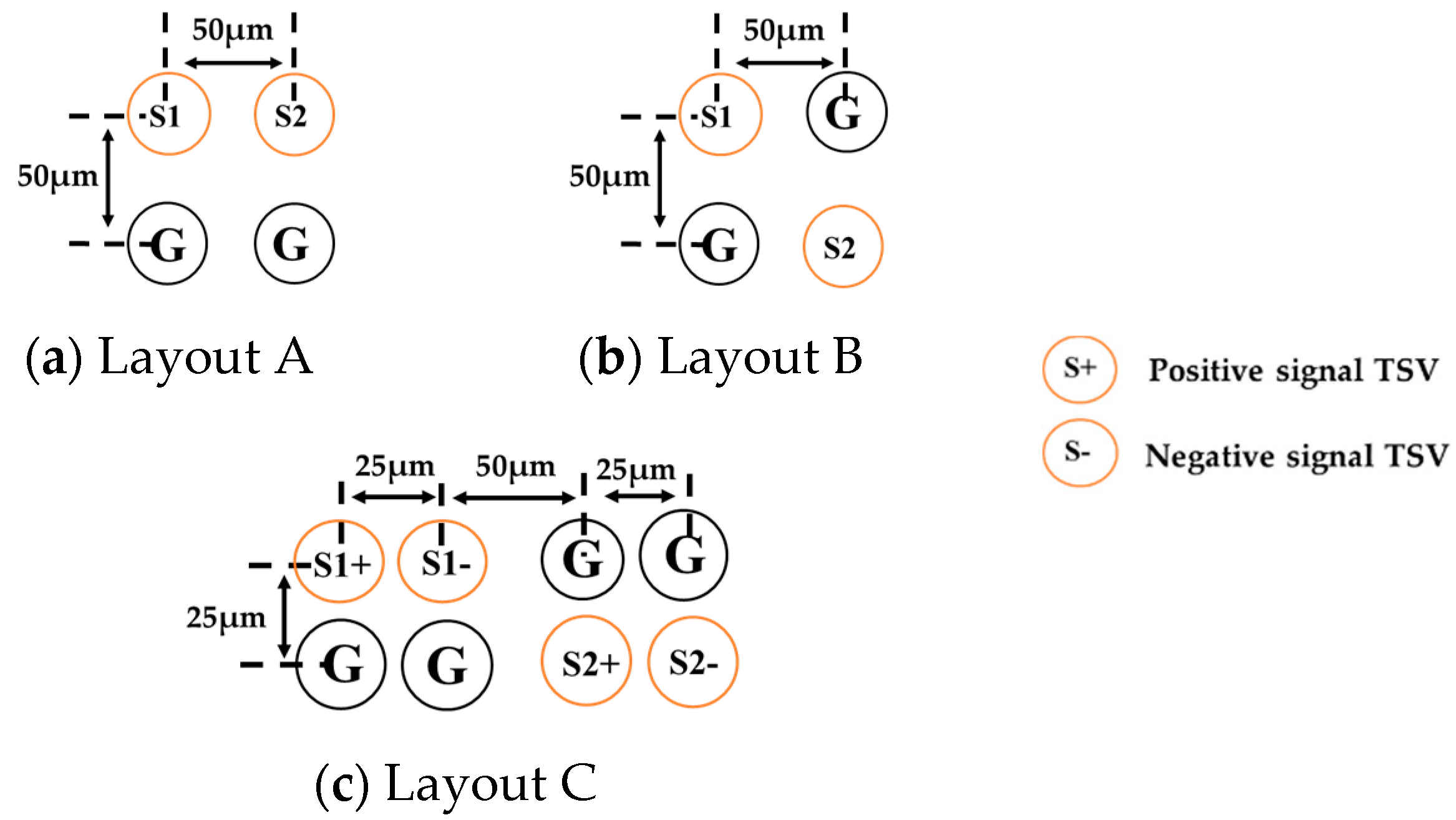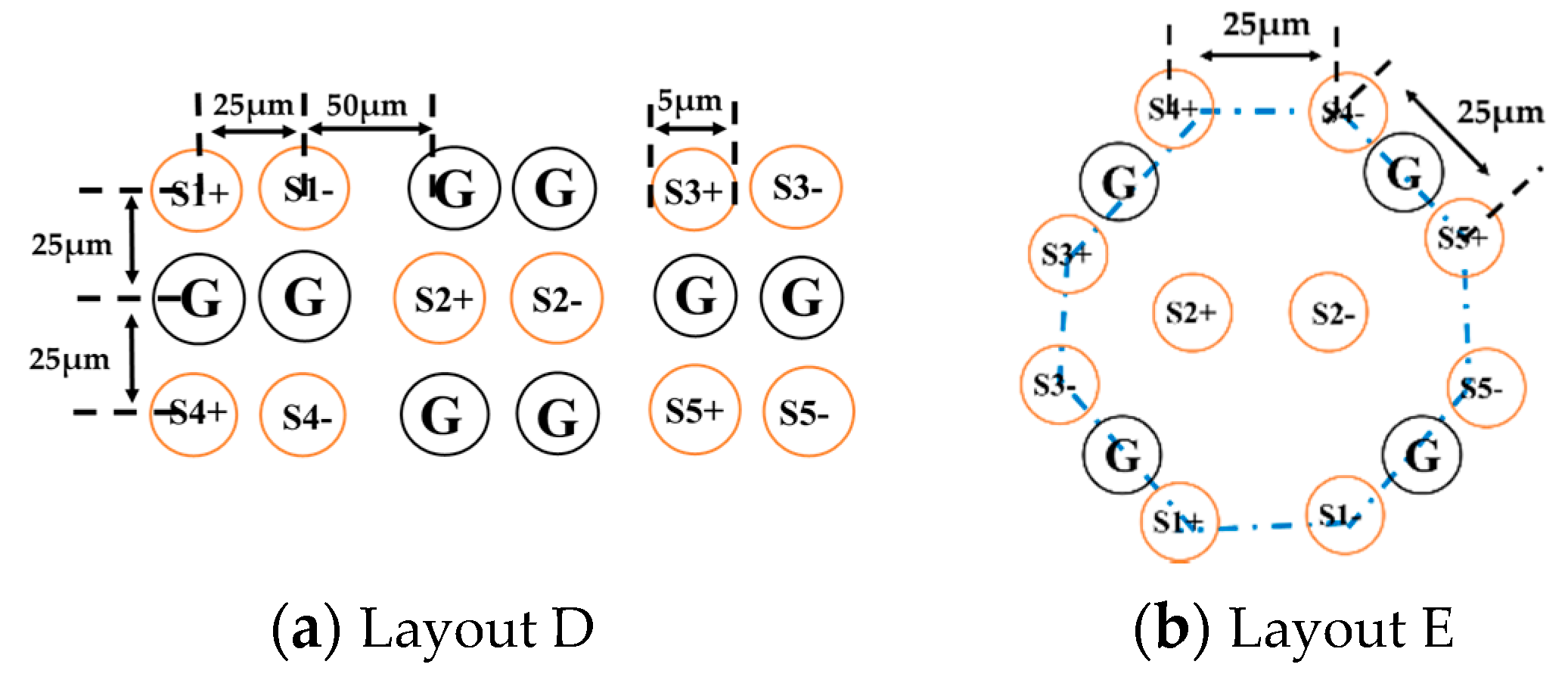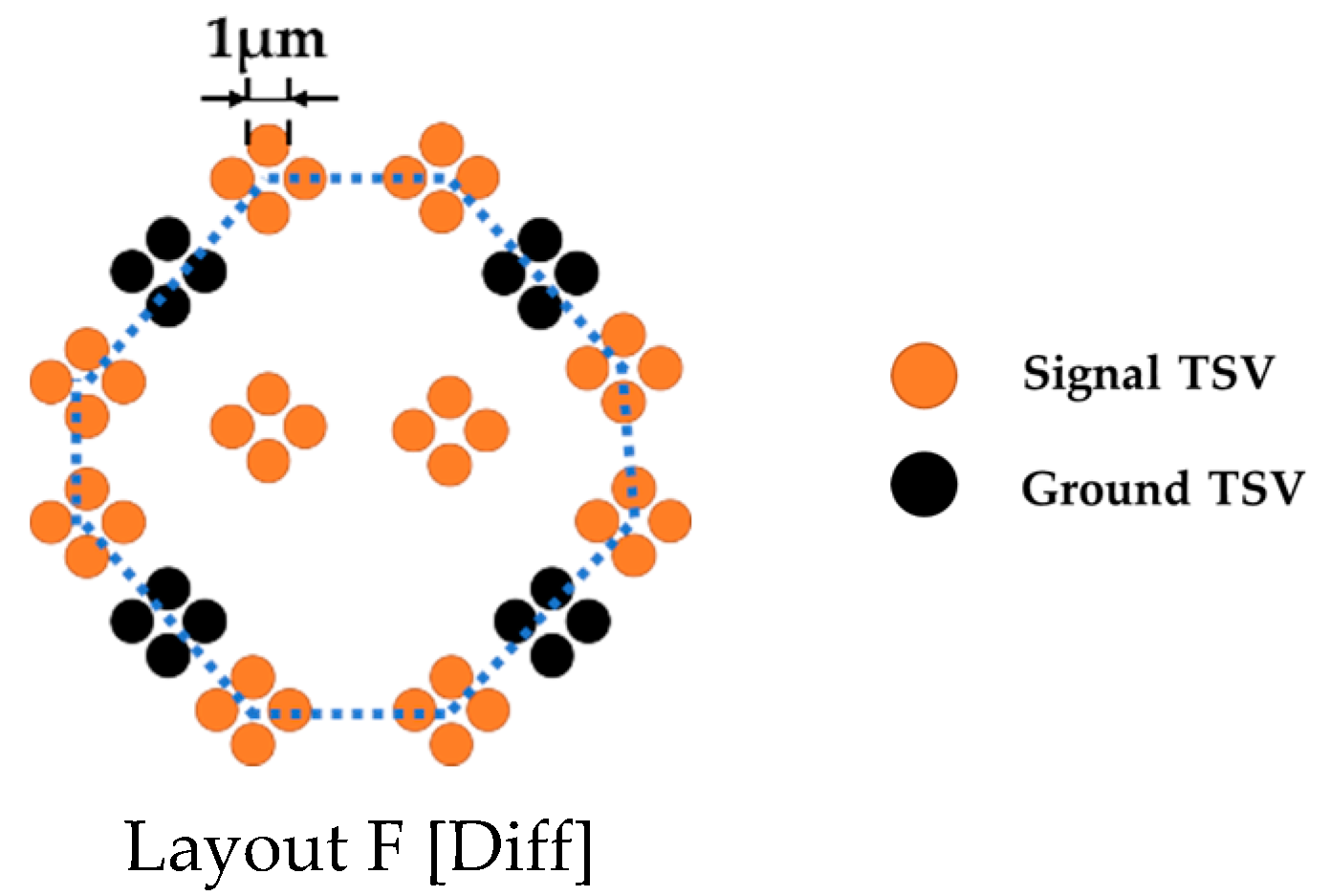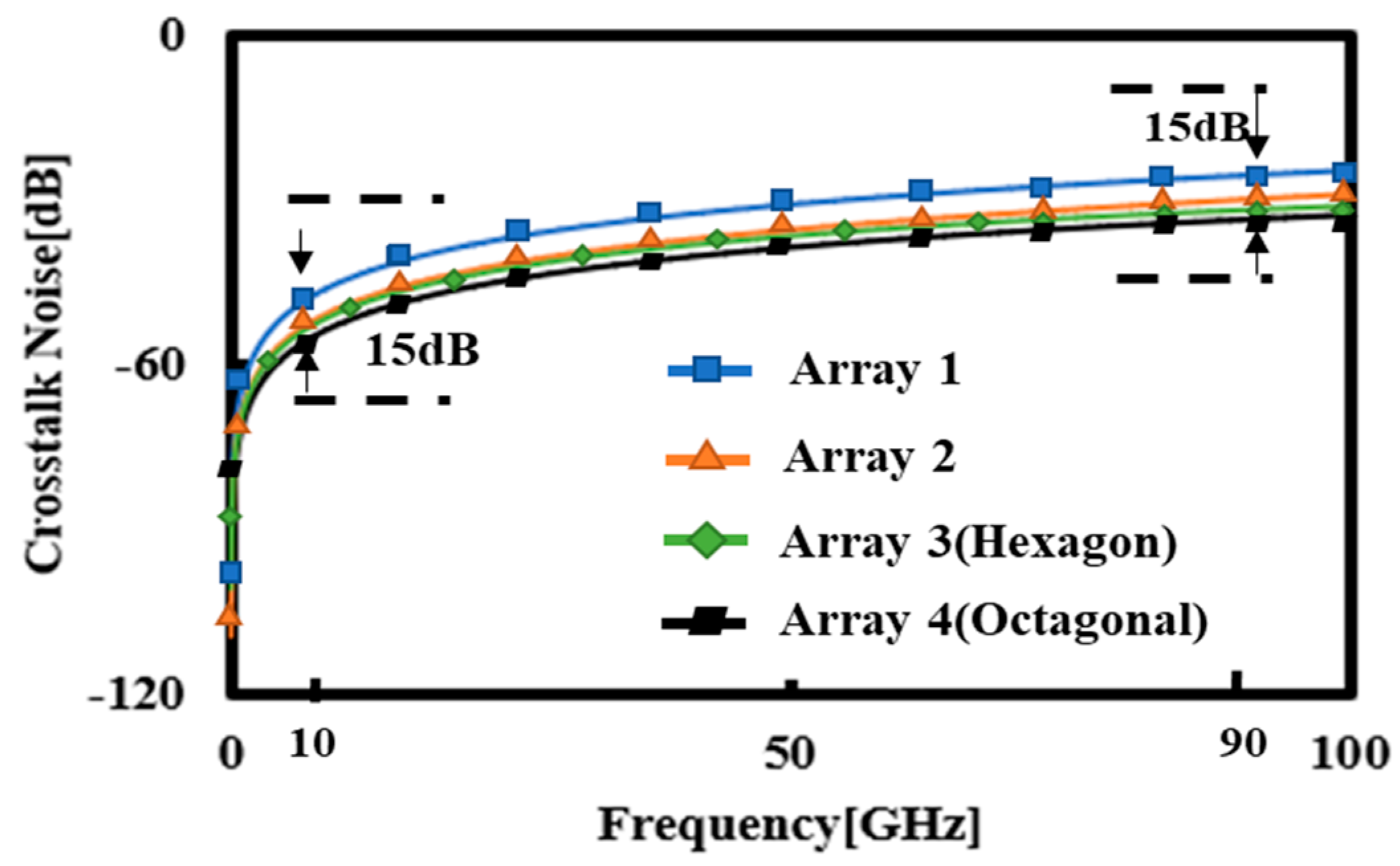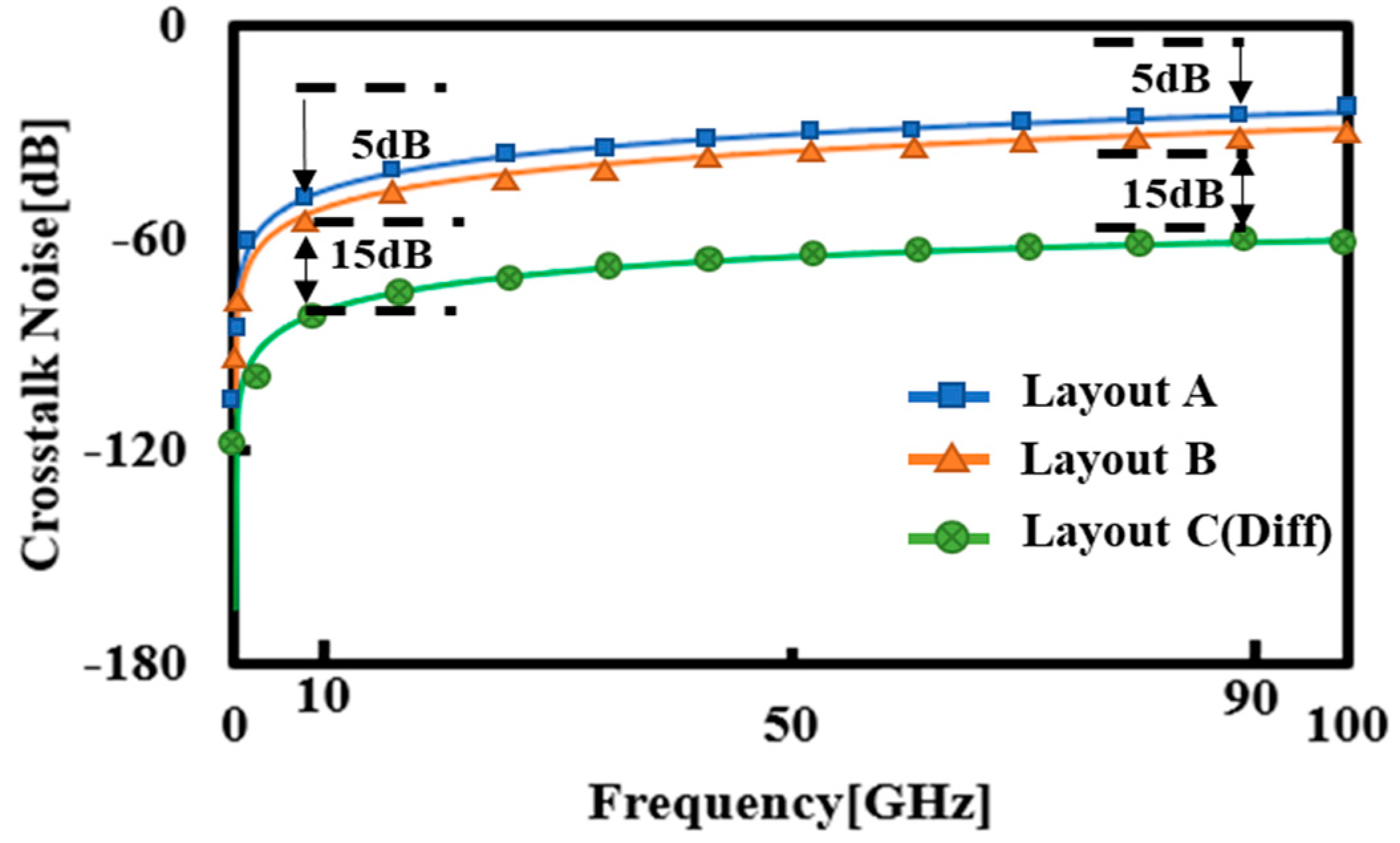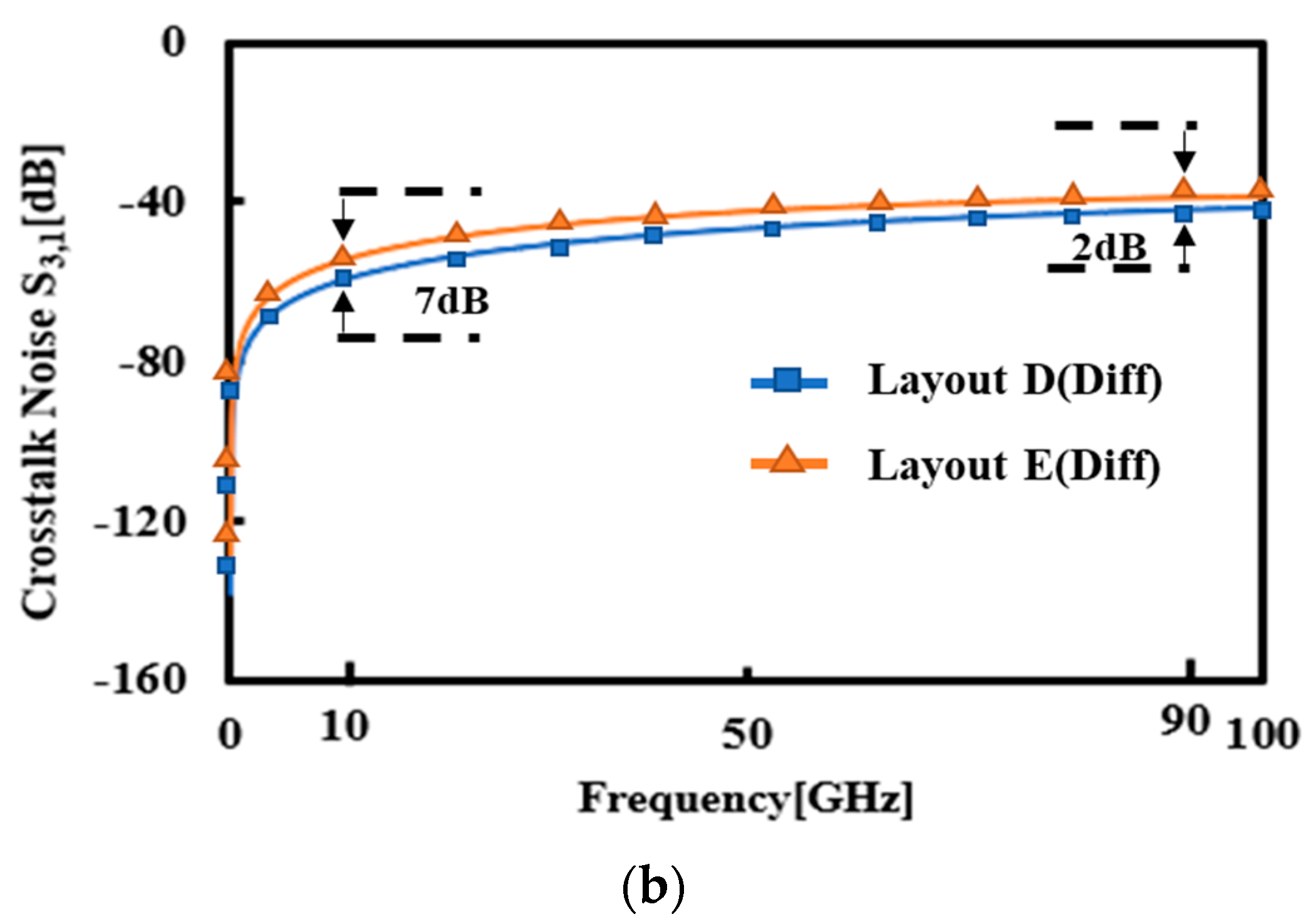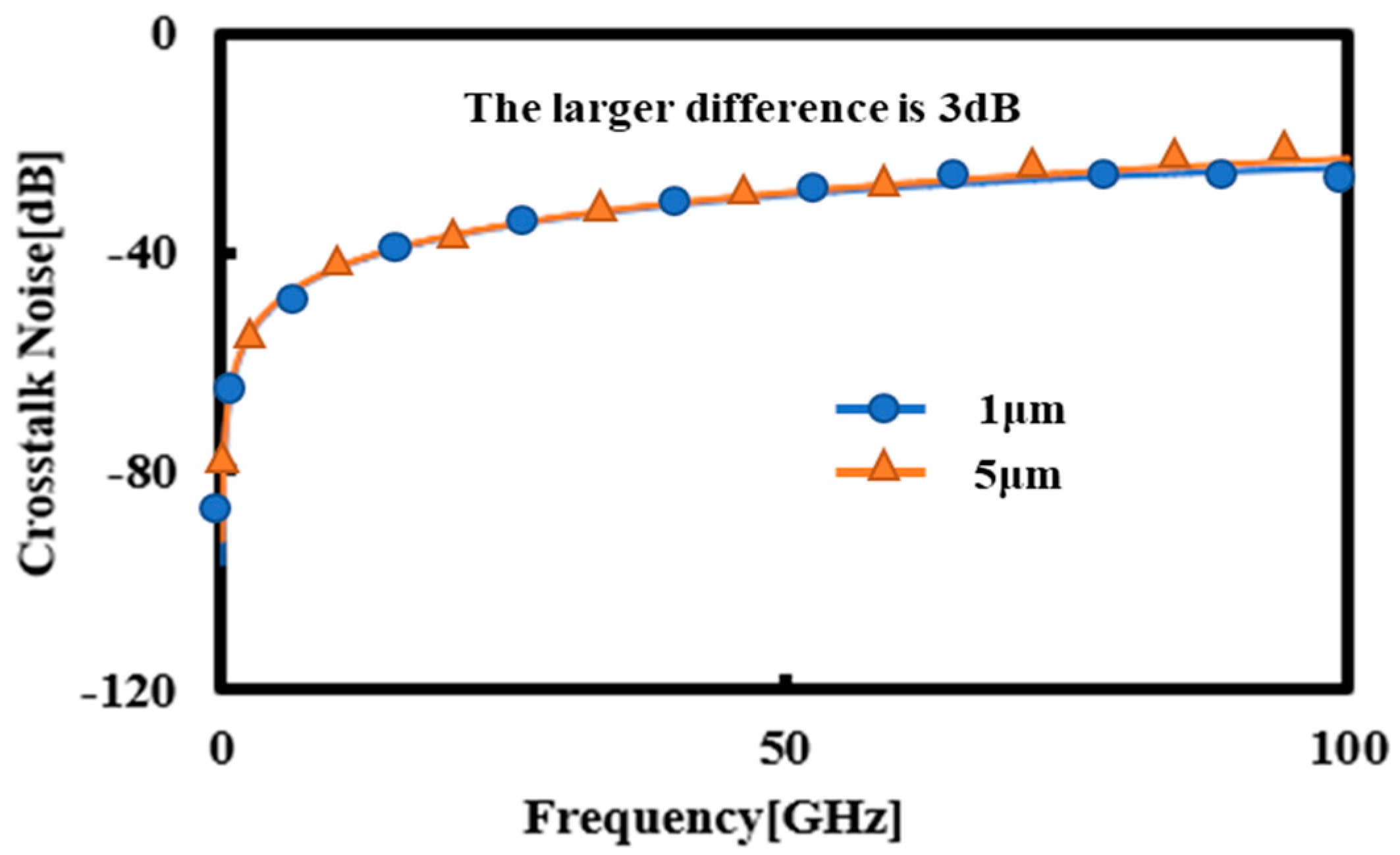1. Introduction
Three dimensional (3D) integration has become one of the most critical technologies in the post-Moore era. TSV technology occupies an extremely important position in 3D integrated circuit (IC). The vertical interconnection of TSV can reduce the length of the interconnection path and decrease the signal delay. As well, it can save the silicon area and increase integration density. Therefore, TSV has become an important technology in the application of 3D IC [
1].
The TSV fabrication process is paid much attention to in recent research, although few studies focus on the signal integrity. However, signal integrity is one of the important criteria to judge TSV electrical performance. The signal is transmitted through the TSV array and thousands of TSVs are placed in the limited silicon chip area. This often causes great electromagnetic interference, including crosstalk noise, which will affect the signal integrity transmitted through TSV [
2]. Therefore, optimizing TSV arrays with signal/ground TSVs to reduce the crosstalk noise has large significance in determining signal integrity. However, TSV arrays should have less ground TSV and occupy less silicon wafer area, which conflicts with better crosstalk noise performance. Therefore, lower-crosstalk noise TSV arrays with smaller silicon area have to be investigated deeply [
3].
The magnitude of crosstalk noise between TSVs is mainly determined by coupling noise, as shown in
Figure 1. The C
ox, R
substrate and C
substrate are the capacitive reactance of the dielectric layer, silicon substrate impedance and capacitive reactance, respectively [
3].
The magnitude of C
ox is expressed as [
3]:
where h is the height of TSV, D is the diameter of TSV, t
ox is the thickness of dielectric layer and ℇ is the dielectric constant of Silicon dioxide, respectively [
3]. The magnitude of C
ox is constant as the t
ox, h, and ℇ are set at a constant value.
Meanwhile, the magnitude of C
substrate and R
substrate can be expressed as [
3]:
where S
TSV is the space between two TSVs, σ
Si is the relative permittivity of silicon substrate,
is the applying angular frequency and
is the dielectric loss tangent. The C
substrate and R
substrate will be increased as S
TSV increases based on Equations (2) and (3), which means that the crosstalk noise between TSVs will be reduced.
As the signal frequency increases, the signal integrity tends to be significantly affected by the transmission path due to the crosstalk noise between two TSVs [
3]. The coupling model of the TSV array is built to investigate the crosstalk noise of large TSV arrays, which shows that the low-resistivity silicon substrate can enhance coupling noise between two TSVs [
4]. Meanwhile, reference [
5] reported the crosstalk noise of TSV arrays by building an analytical model based on the theory of multiconductor transmission lines (MTLs), which is more accurate and quicker than the traditional analytical model. To suppress the crosstalk noise, de-embedding test structures and the CPW structure for measuring the crosstalk noise between two TSVs was proposed in the references [
6,
7]. Compared with the de-embedded structure, the CPW structure can measure crosstalk noise more accurately. The effect of the TSV pitch on the crosstalk noise of mutual TSVs is also reported as being that the crosstalk noise increases as pitch decreases [
8]. Compared with the traditional TSV mesh array topology, the hexagonal TSV array can decrease the crosstalk noise and reduce the silicon area [
9].
However, research on reducing crosstalk noise in TSV array is seldom found and more research focuses on the process and thermal stress of TSVs in recent years. Meanwhile, there is little current research on using differential signals to TSV, such as references [
10,
11]. Therefore, this paper proposes an octagonal TSV array arrangement based on the studies referred to above and the CPW structure is used to measure the crosstalk noise, as shown in
Figure 2. The octagonal TSV array with inputs taken as single signal and differential signal both have lower crosstalk noise than traditional TSV arrangements. Meanwhile, the area occupied by the octagonal array is also the smallest. Furthermore, a method to reduce the area without reducing the ability of suppressing crosstalk noise is also proposed by dividing a large TSV into four smaller TSVs, which also largely saves the silicon area.
3. Results and Discussion
The crosstalk noise of traditional TSV arrays (arrays 1 and 2), hexagonal array and octagonal array with single-ended TSV, are shown in
Figure 9, obtained by ANSYS HFSS from the American ANSYS Company, Commonwealth of Pennsylvania, US. As the frequency increased, the crosstalk noise of the octagonal array slightly decreased. At low frequencies, the signal was only transmitted in a single TSV, and would not penetrate the silicon substrate to affect other TSVs [
3]. Therefore, the crosstalk noise curve of any array overlapped when the diameter was a constant value as shown in
Figure 9. Compared with arrays 1 and 2, the crosstalk noise of array 4 was reduced by 15 dB and 5 dB, respectively, when the frequency was over 20 GHz. The main reason for this was that the octagonal structure can reduce the area while increasing the pitch of two signal TSVs, as shown in
Figure 3. Compared with array 3 (hexagonal array), the octagonal array could also reduce the crosstalk noise by 2 dB. The main reason for this was that the grounded TSV between two signal TSVs in the octagonal array was closer to the coupling path than the hexagonal TSV; thus, the ability of shielding noise was better even though the space between two signal TSVs was smaller. The crosstalk noise of layout B was higher than layout A by nearly 5 dB when the frequency was over 1 GHz, as shown in
Figure 9. The main reasons were as follows: (1) the staggered signal and ground TSV array increased the distance between adjacent signal TSV and signal TSV. (2) The staggered signal and ground TSV array made one signal TSV surrounded by two ground TSVs, which could greatly suppress the crosstalk noise without changing TSV pitch and total array area.
The crosstalk noise between layout B and layout C(Diff) in
Figure 4b,c is shown in
Figure 10. When the two single-end TSVs in layout B were substituted by one pair of differential TSVs in layout C(Diff), the crosstalk noise of layout C(Diff) was largely reduced by nearly 15 dB over 10 GHz. The main reason for this was that the differential signal had a great ability of anti-electromagnetic interference, which can effectively decrease crosstalk noise. Notably, the silicon area of layout C(Diff) was equal to layout B.
The results of
Figure 9 verified that the staggered TSV array with differential signal had the ability to suppress crosstalk noise, which could be reduced 40% at high frequency. In layout C(Diff), the number of signal TSVs increased but the total area of substrate was the same as for layouts A and B. Therefore, differential staggered arrangement could better suppress crosstalk noise without changing the occupied silicon area. However, the number of grounded TSVs was the same as the signal TSV in the layout C(Diff).
To further save more silicon area by using less ground TSV, differential signals were used in our new octagonal array as shown in
Figure 5b. Layout D(Diff) in
Figure 5a was a topologic array of layout B, which was to keep the same signal TSV. Five pairs of differential signal TSVs were arranged and the area of the TSV array in layout D(Diff) and E(Diff) was 8750 μm
2 and 3017.5 μm
2, respectively. Consequently, layout E(Diff) had a smaller area than layout C(Diff). Besides, it also contained less ground TSV and more signal TSV to transmit data.
Crosstalk noise was further investigated for the layout E(Diff) with less ground TSV and array area. This study chose the representative signal parameters S1,2 and S1,3, where S1,2 meant the signal crosstalk noise between S1 and S2. For the anti-electromagnetic coupling ability of the differential signal, only when the positive and negative signals received the same magnitude of external interference could the internal mutual crosstalk noise be cancelled and, thus, could the differential signal reduce anti-electromagnetic coupling. S1, S2 and S3 were the integration signals of S1+/S1−, S2+/S2 and S3+/S3−.
Figure 11a showed the crosstalk noise S2,1 between layout D(Diff) and layout E(Diff). The crosstalk noise of layout E(Diff) was lower than layout D(Diff) with the signal frequency increasing. When the frequency was 10 GHz, the crosstalk noise difference between the two layouts was as high as 45 dB. When the positive and negative signals in a pair of differential signals received the same external interference, the internal crosstalk noises could counteract each other. In the layout E(Diff), S2+ and S2− suffered from the same interference from S1+ and S1−, therefore the crosstalk noises between S2+ and S2− could counteract each other. However, the distance between S1+/S1− and S2+/S2− was inconsistent in layout D(Diff), resulting in a crosstalk noise difference between S1+/S1− and S2+/S2−. Therefore, the crosstalk noise between S2+ and S2− could not be counteracted in the layout D(Diff).
Figure 11b showed that the difference in crosstalk noise S1,3 between layout D(Diff) and layout E(Diff) was very small. It was worth noting that layout E(Diff) had less shielded ground TSV than layout D(Diff), which meant that less ground TSV was used to achieve the same shielding effect, which meant an effectively reduced TSV area. The octagonal TSV array arrangement had great advantages in reducing the area and decreasing the crosstalk noise.
The crosstalk noises among layouts A, B, D(Diff) and E(Diff) are shown in
Table 2. Therefore, the layout E has the greatest ability to reduce crosstalk noise in comparison with other arrays.
The crosstalk noise between two adjacent TSVs of regular and new structure in only TSV array as shown in
Figure 7 was investigated as shown in
Figure 12. Compared with regular TSV, the new TSV structure reduced the crosstalk noise by 3 dB at 100 GHz. The main reason may be that the influence path increased between two new TSVs as the diameter of the new TSV reduced. Then, the regular and new structure applied in TSV arrays as shown in
Figure 4b and
Figure 8 were simulated by HFSS.
Layout F(Diff) was designed with a smaller TSV being substituted for a large TSV to further decrease the occupied silicon area. The crosstalk noise between layout E(Diff) and F(Diff) is shown in
Figure 13. Although the resistance of the new TSV structure was increased by 0.02 Ω, the crosstalk noise did not increase compared with the regular TSV. Notably, the area of a single TSV after optimization was reduced by 7.065 μm
2 compared to before optimization. The total area of the entire TSV array was reduced by 98.91 μm
2.
4. Conclusions
Compared with the traditional two TSV array layouts (parallel and staggered array) and a hexagonal array, the octagonal TSV array that we proposed had a better ability to suppress the crosstalk noise. When the frequency is over 20 GHz, the crosstalk noise is reduced by 15 dB, 5 dB and 2 dB, respectively.
To further decrease the crosstalk noise, we summarize the effect of two traditional TSV arrays with single-end and differential signals on suppressing crosstalk noise. It is concluded that the staggered layout with differential signals can reduce the coupling by up by 44% at high frequencies in the same area.
On this basis, a differential signal is used in the octagonal TSV array. Compared to the staggered TSV array with a differential signal, the octagonal TSV array with a differential signal can further reduce the crosstalk noise, which can be reduced by about 60% at 10 GHz. At the same time, the number of shielded grounded TSVs is less and the total area of the silicon substrate is smaller.
Furthermore, the design in which one large TSV is changed into four smaller TSVs in the octagonal TSV array can maintain the ability of reducing crosstalk noise in a regular TSV array. Most importantly, the single TSV area is reduced by 7.065 μm2 and the total area is reduced by 98.91 μm2 when the new TSV structure replaces the regular TSV in an octagonal TSV array.
